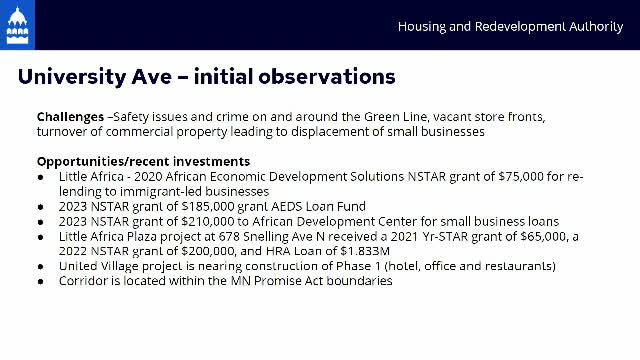City leaders outline ambitious plans to revitalize commercial corridors
September 04, 2024 | St. Paul City, Ramsey County, Minnesota
This article was created by AI summarizing key points discussed. AI makes mistakes, so for full details and context, please refer to the video of the full meeting. Please report any errors so we can fix them. Report an error »

During a recent government meeting, officials discussed ongoing efforts to revitalize commercial corridors in the city, particularly focusing on safety, crime, and economic development. The conversation highlighted several key areas, including University Avenue and Robert Street, where challenges such as vacant storefronts and underutilized land persist.
In the University Avenue corridor, particularly around Snelling, officials noted the importance of upcoming construction projects, including the United Village Project, which is set to begin its first phase soon. This development is expected to generate momentum for further investments in the area, despite existing safety concerns.
Similarly, Robert Street faces issues with commercial activity and vacant properties. Public works has applied for a regional grant to support improvements, while community engagement events are being organized to activate the corridor. Officials mentioned the potential for rezoning studies to facilitate development in both Robert Street and Grand Avenue, where recent zoning changes have already been implemented to encourage business growth.
The Grand Avenue area has faced its own challenges, including a history of mismanagement within the local business association and a prohibitive sign ordinance that has made it difficult to attract new tenants. In response, the Saint Paul Chamber has been engaged to boost membership and community involvement, while small improvements, such as painting light poles, have been made to enhance the area's appearance.
Looking ahead, officials expressed a commitment to conducting a comprehensive analysis of the commercial corridors, aiming to develop a long-term strategy that addresses the unique needs of each area. This strategy may include funding support for local organizations, direct loans to businesses, and further zoning studies to create a more conducive environment for development.
The meeting concluded with discussions about the need for potential amendments to the sign ordinance, which has been identified as a barrier to vibrant signage and business visibility. Officials acknowledged the importance of involving local business associations in these conversations to ensure that their needs and priorities are addressed in future planning efforts.
In the University Avenue corridor, particularly around Snelling, officials noted the importance of upcoming construction projects, including the United Village Project, which is set to begin its first phase soon. This development is expected to generate momentum for further investments in the area, despite existing safety concerns.
Similarly, Robert Street faces issues with commercial activity and vacant properties. Public works has applied for a regional grant to support improvements, while community engagement events are being organized to activate the corridor. Officials mentioned the potential for rezoning studies to facilitate development in both Robert Street and Grand Avenue, where recent zoning changes have already been implemented to encourage business growth.
The Grand Avenue area has faced its own challenges, including a history of mismanagement within the local business association and a prohibitive sign ordinance that has made it difficult to attract new tenants. In response, the Saint Paul Chamber has been engaged to boost membership and community involvement, while small improvements, such as painting light poles, have been made to enhance the area's appearance.
Looking ahead, officials expressed a commitment to conducting a comprehensive analysis of the commercial corridors, aiming to develop a long-term strategy that addresses the unique needs of each area. This strategy may include funding support for local organizations, direct loans to businesses, and further zoning studies to create a more conducive environment for development.
The meeting concluded with discussions about the need for potential amendments to the sign ordinance, which has been identified as a barrier to vibrant signage and business visibility. Officials acknowledged the importance of involving local business associations in these conversations to ensure that their needs and priorities are addressed in future planning efforts.
View full meeting
This article is based on a recent meeting—watch the full video and explore the complete transcript for deeper insights into the discussion.
View full meeting
